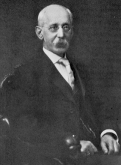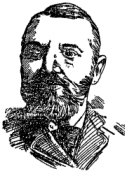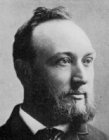Amateur observers of variable stars in the United States from 1875 to 1910.
The full text of this article appears in the Journal of the AAVSO, Vol. 27, No. 2, 1999.
For 35 years before the formation of the AAVSO, independent amateur variable star astronomers in the United States were making significant contributions to the field. The most notable of these skilled and dedicated individuals were: Seth C. Chandler, Jr. of Cambridge, Mass.; Edwin F. Sawyer of Brighton, Mass.; and Paul S. Yendell of Dorchester, Mass. Other accomplished amateur variable star astronomers at this time were John H. Eadie of Bayonne, New Jersey; Henry M. Parkhurst and Arthur C. Perry of Brooklyn, N.Y.; John A. Parkhurst of Marengo, Illinois; and William E. Sperra of Randolph, Ohio.
 |
| Seth C. Chandler, Jr. |
Chandler was a skilled mathematician and a tireless computer. He is best known today for his three early variable star catalogues, and for his determination of the Earth's variation of latitude. In 1878 he published a series of articles on how to observe variable stars. Between 1881 and 1885, Chandler worked as a volunteer observer and researcher at the Harvard College Observatory. Despite his great skill and expertise in astronomy, he preferred to remain an independent amateur, while he earned his living as an actuary for an insurance company. He won international acclaim for his accomplishments in astronomy.
 |
| Edwin F. Sawyer |
Sawyer--a bank clerk all his life--was known as an accurate and hard-working observer. He began making variable star observations in 1865. Sawyer was "discovered" in 1876 by Chandler, who encouraged him to do more observing. In 1892 Sawyer published a catalogue of magnitudes of 3,415 southern stars.
Yendell--who worked as a store clerk, soldier, bank clerk, and draftsman--began variable star observing in 1887, also at the urging of Chandler. Between 1888 and 1916 Yendell contributed over 125 variable star notes to the Astronomical Journal. Between 1894 and 1906 he wrote over 140 pages of articles about variable stars and observing methods in Popular Astronomy.
Eadie contributed several hundred variable star observations to the Harvard College Observatory (HCO) between 1880 and 1911. Of these early observers, Yendell and J. A. Parkhurst (who went on to become a professional astronomer) later contributed observations to the AAVSO once it was formed.
 |
| Benjamin A. Gould |
The discoveries and comments of Chandler, Sawyer, Yendell, and other accomplished amateurs appeared in the U.S. mainly in The Astronomical Journal, edited by Benjamin A. Gould, and published in Boston. Gould (born in 1824) was the first American astronomer to receive part of his training in Germany. He became a pupil and friend of Encke, Gauss, Struve, Argelander, and others. Of particular importance for Gould's work was his acquaintance with, and the influence of, the German astronomer Argelander. It was Argelander--through publication of his star catalogue, the Uranometria Nova, in 1843--who encouraged worldwide interest in the study of variable stars. Gould's own important work, the Uranometria Argentina (1879)--a catalogue of southern stars--was an extension of Argelander's catalogue.
From Germany and from Argentina, Gould brought his interest in variable stars to the United States where he supported the variable star work of the early amateur observers. The first amateur astronomer in the United States to answer Gould's 1856 call for variable star observations was Stillman Masterman, of Maine. Masterman's observations appeared in Gould's journal between 1857 and 1861. A promising amateur career was cut short when Masterman died at the age of 32.
 |
| Edward C. Pickering |
In 1882, Harvard College Observatory (HCO) Director Edward C. Pickering published "A Plan for Securing Observations of the Variable Stars" in which he proposed enlisting the help of volunteer observers. He did not, however, actually propose the establishment of a formal organization of amateur observers.
Throughout the 1880s and 1890s, Pickering, Yendell, J. A. Parkhurst, and others, made appeals to amateur astronomers, similar to Gould's and Pickering's, to take up variable star observing, and either publish their observations or contribute them to HCO or other observatories for further study. Appeals for observers and "how to observe variable stars" articles began to appear in the prominent astronomy journals of the day: The Sidereal Messenger, Astronomy and Astro-Physics, and Popular Astronomy.
With the emergence of new observing techniques such as photography and spectroscopy, thousands of new or suspected variable stars were being discovered during the 1890s. This proliferation of discoveries overwhelmed the resources of observatories such as HCO, and underscored the need for many more amateur astronomers to become involved in observing variable stars. Chandler, Pickering, and others involved in variable star work were aware of the rapidly expanding field. They agreed that more observations of these stars would be vital towards understanding them, and they agreed that variable star work could be done by amateurs with modest means.
The key to involving many more amateurs in variable star observing--while ensuring the quality and consistency of measurements--would be to provide standard sequences of comparison stars that have assigned magnitudes. For the novice observer, this would make variable star measurement a much simpler activity than having to follow the cumbersome step method, and it would do away with the laborious reductions needed to derive a light curve.
In 1891, Pickering published sequences of comparison stars, and by 1906 he was making charts available with comparison stars marked on them, and instructing observers in the simpler observing technique of comparing the variable star to comparison stars of known, standard magnitudes.
Between 1906 and 1910, Pickering reported, about 6000 observations of long period variable stars were "kindly communicated by other astronomers." Among them were: Professor Anne S. Young of Mt. Holyoke College; Frank E. Seagrave of Providence, R.I.; John H. Eadie of Bayonne, N.J., and several astronomers, assistants, and students at Vassar College, including Ida Whiteside, Helen Swartz, Psyche R. Sutton, Professor Mary Whitney, Professor Caroline Furness, and others. The AAVSO archives show that Ida Whiteside, Helen Swartz, and Professor Mary Whitney, contributed over 3,200 variable star observations to Pickering from 1902 through October 1911. Ida Whiteside alone sent reports of at least 2,507 observations of variable stars to HCO between 1904 and 1909. Helen Swartz, of Norwalk, Connecticut (who became a high school mathematics teacher there), was later both a Charter Member and a Life Member of the AAVSO, and Caroline Furness was a Charter Member. helen Swartz was also one of the first Council members of the AAVSO when it was formally organized in 1917.
By 1910, the contributions of new amateur variable star observers were eclipsing those of the earlier expert amateurs by sheer number of observations made. Quantity as well as quantity was important in order to obtain light curves of these stars that were as complete as possible.
Circumstances had now come together to make the time right for the organization of amateur variable star observers:
- professional astronomers had an urgent need for more observations of variable stars;
- the prospect of making a real contribution towards scientific research fired the enthusiasm of amateur astronomers;
- and the availability of standard sequences of comparison stars and charts made it possible for even the novice observer to take up this work.
It was amateur astronomer William Tyler Olcott who took up the challenge and offered his services to Pickering help collect observations, and distribute charts and give advice to other interested amateurs. In the November, 1911 issue of Popular Astronomy, Olcott offered to correspond with anyone interested in organizing to observe variable stars.
Now with an organization envisioned, a handful of dedicated volunteer observers, and a worthwhile scientific purpose defined, the AAVSO was about to achieve "first light."
- Continue to Part Two of the AAVSO History: The emergence, founding, and growth of the AAVSO

